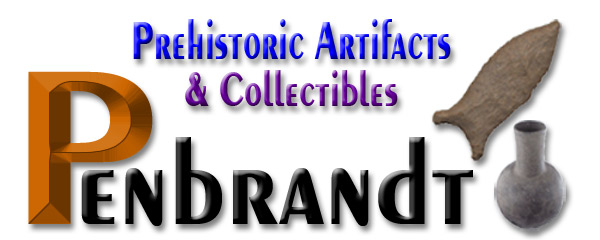
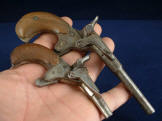 |
- Item: M101
- Description: Rare Matched Pair of 19 Century Flobert or Parlor Pistols - Louis Nicolas Auguste Flobert, in Paris, developed in 1847 his rim fire cartridge, which is patented 23 July 1849. At the same time he developed his breech-loading system.
These pistols
which fires a low pressured rim fire bullet breech cap, probably caliber 5mm as shown in the advertisement. (see photo)
Parlor pistols and rifles as they were known in the United States is derived from (zimmerschutzen from German, "room marksman" or "room shoot") were popularized in the mid to late 19th Century, particularly in the Germanic countries, as a way to entertain guests, have family fun, and to increase one's shooting skills. In the 19th century “parlor” pistols were made for the purpose of casual indoor plinking. Many countries made ammunition for these pistols as shown on this chart. I have been told that in the US, in the larger cities, in the 1800's that "Parlors" were opened on the streets, where a man or woman could step in and shoot and paper and other targets with these pistols. The 1st rounds used only the primer to discharge the projectile without any extra black powder, so you can imagine that the target range was short. These are probably the only existing examples from this maker. The larger pistol has a serial # of 8.
- Size: Men's - 6 1/4 x 3 inches with 3 7/8 inch Barrel
- Women's - 4 x 2 5/8 inches with 2 inch Barrel
|
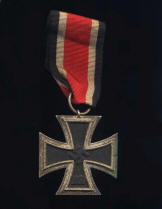 |
- Item: M102
- Description: World War II German Iron Cross 2nd Class Medal with Ribbon - This is a original World War II German IRON CROSS.
Adolf Hitler restored the Iron Cross in 1939 as a German decoration (rather than Prussian as in earlier versions), continuing the tradition of issuing it in various grades. Legally it is based on the enactment (Reichsgesetzblatt I S. 1573) of 1 September 1939 Verordnung über die Erneuerung des Eisernen Kreuzes (Regulation of the renewing of the Iron Cross). The ribbon of the medal 2nd class was different from the earlier Iron Crosses in that the color red was used in addition to the traditional black and white (black and white were the colors of Prussia, while black, white, and red were the colors of Germany).
The standard 1939 Iron Cross was issued in the following two grades: Iron Cross 2nd Class (Eisernes Kreuz 2. Klasse); Iron Cross 1st Class (Eisernes Kreuz 1. Klasse) (abbreviated as EKI or E.K.I.) The Iron Cross was awarded for bravery in battle as well as other military contributions in a battlefield environment. The Iron Cross 2nd Class came with a ribbon and was worn in one of two different methods: When in formal dress, the entire cross was worn mounted alone or as part of a medal bar; For everyday wear, only the ribbon was worn from the second hole in the tunic button.
Size: Approx 4 inches in length with ribbon, Cross is 1 3/4 x 1 3/4
|
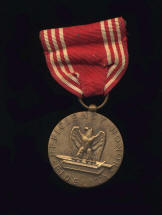 |
- Item: M103
- Description: World War II US Good Conduct Medal & Ribbon -
This is an Original good conduct medal. It was given to those who never got into legal trouble in the armed forces. Tons of soldiers got into all kinds of trouble and more than a few served prison sentences, of course theses soldiers didn't recieve the good conduct medal.
- Size: 1 1/4 x 1 1/4 without ribbon, length is 2 3/4 including ribbon
|
 |
- Item: M104
- Description: Sterling WW2 Combat Infantry Badge -
This award was unique in that the recipient had to have engaged in combat against an armed enemy. The requirement of combat against an armed enemy meant just that and general officers and officers above Regimental Colonel were not entitled to receive the medal (although I believe that I have seen pictures of Generals wearing it). There are basically three requirements for award of the CIB. The soldier must be an infantryman satisfactorily performing infantry duties, must be assigned to an infantry unit during such time as the unit is engaged in active ground combat, and must actively participate in such ground combat. Campaign or battle credit alone is not sufficient for award of the CIB."
Double post, 3" across w/clutches. Marked "STERLING " on back, w/blue enamel on front. This is in excellent condition.
- Size: 2 9/16+ x 7/8 inches
|
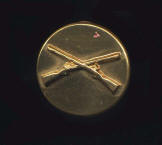 |
- Item: M105
- Description: WW2 Army Infantry Brass Collar Pin - This is from the estate of a Kentucky Veteran. One Clutch is missing.
- Size: 1 x 1 inch
|
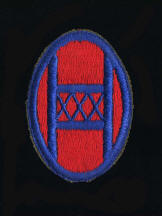 |
- Item: M106
- Description: 30th Infantry Division WW2 Patch -
The 30th Infantry Division was made up of the existing National Guard units from the States of North and South Carolina, Georgia and Tennessee at the beginning of WWII. During WWII, The 30th Infantry Division served in Europe with distinction, and was designated as the #1 Infantry Division in the European Theater by Gen. Eisenhower's Chief Historian, Col. S.L.A. Marshall. Although the 30th Infantry Division was not involved in the actual invasion of Normandy, the 30th served valiantly at St. LO and at Mortain in France; it was the first infantry division to enter Belgium and The Netherlands. The 30th was also instrumental in breaching the Siegfried Line in October 1944, and the capture of Aachen, Germany, the 1st large German city to be captured by the Allies in WWII. The 30th made a rapid advance around the north side of the Ruhr Industrial Pocket, capturing Brunswick and finally capturing Magdeburg on the Elbe River on 17 April 1945. Here the 30th Infantry Division met the Russians and remained in occupation of Magdeburg throughout the month of May, when it was turned over to the Russians for their permanent occupation, as this was their designated occupation
territory. This brought the end of the war to the 30th Infantry Division. After a brief occupation of an area on the Czech border, the 30th was alerted to return to the United States for further deployment to the Pacific. However, enroute to the U.S.A., the war in the Pacific came to an end by the dropping of the atomic bomb on Japan. The 30th infantry Division was proudly called "Old Hickory" after Andrew Jackson, the 7th President of the United States. The 30th returned to Ft. Jackson, SC where it had originated, and was deactivated on 25 November 1945
- Size: 2 3/8 x 1 9/16 inches
|
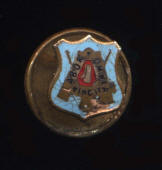 |
- Item: M107
- Description: Unknown "Labor Omnia Vincit" pin - Here is an unknown pin with a shield of blue enamel with the Latin phrase "Labor Omnia Vincit" which means "Labor Conquers All" or "Hard Work Conquers All". It may be Sterling, but I am not sure. It may be Masonic as it appears to have a compass & square on it. Also, the center impression appears to be a wood plane. Clutch is brass and screws on.
- Size: Approx 1/4 x 5/16 inches
|
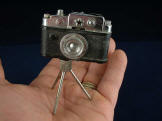 |
- Item: M108
- Description: Vintage "Occupied Japan" Camera Cigarette Lighter - Here is a really unusual cigarette lighter that is made as a 35mm camera. The lens screws off to fill it with lighter fluid. The flint screw tube is accessed through the bottom and the "shutter release" strikes the lighter. The tripod may be removed. It is stamped "Made In Occupied Japan" on the bottom. (see photo) Probably made between 1945 and 1952. This was acquired from the estate of a WW2 Veteran. A very FINE find for your cigarette lighter or Tobacciana collection.
- Size: 2 1/16 x 1 1/2 camera only, approx 3 1/2 inches tall with tripod
|

[
Paleo | Archaic | Woodland | Mississippian | HardStone | Pottery | Slate & Bone | Our Guarantee |
How To Order |
Home
]
[ Advertising | Books | Lamps & Lamp Parts | Collectible Pottery & Glassware |
Miscellaneous | Primitives ] |


